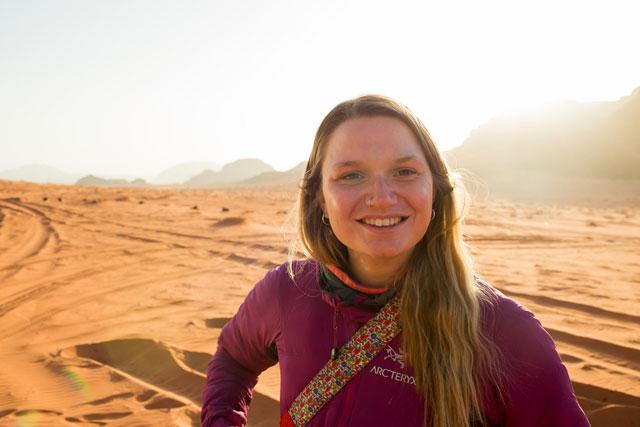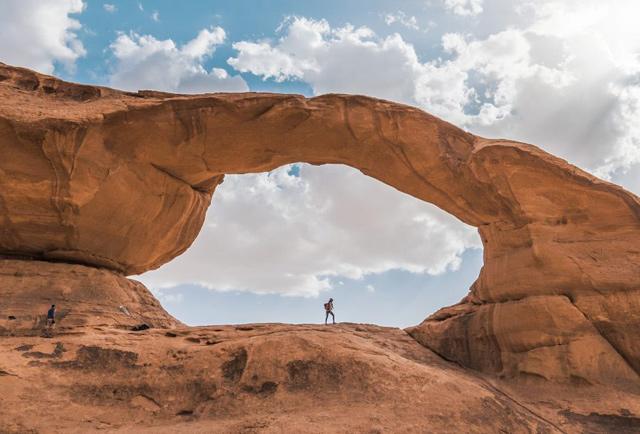You are here
Growth of hiking community shapes ‘alternative narratives of Middle East’— scholar
By Saeb Rawashdeh - Mar 16,2017 - Last updated at Mar 16,2017

Olivia Mason at the Jordan Trail between Dana Reserve and Petra (Photo courtesy of Barqawi Studios)
AMMAN — After being denied reentry to Palestine by Israeli authorities, one geographer began another study of the relationship between people and place, this time immersed in the emerging culture of hiking along the 600-kilometre-long Jordan Trail.
“My interest in the Middle East came by chance, as I come from a geography background and I have always been interested in the role of tourism in enabling perceptions of places and spaces,” Olivia Mason, a PhD candidate in Human Geography from Durham University in the UK, told The Jordan Times in a recent interview.
During her undergraduate studies at Newcastle University she was encouraged to research tourism and its role in “constructing post-conflict narratives”.
Spending time in Bosnia and Herzogovina, Mason became “fascinated with the role of the tour guides in providing particular accounts of place”, she said, adding that she also explored adventure tourism and “the growth of the hiking culture in its ability to translate alternative understandings of place”.
“I had always had an interest in post-conflict tourism and tourism in conflict zones and its relationship with narratives of place,” the geographer underlined.
“For my masters of research I looked at Palestinian female bloggers and how they were able to translate conflict through their blogs; the relationship between offline/online space, embodiment in blogs and the power of blogs to impart an emotional politics,” Mason explained.
Gradually, she became more interested in the Middle East, and Palestine in particular, but despite her desire to study how the tourism industry and hiking in Palestine portray the political situation and alternative versions of Palestinian society, she was denied reentry by Israeli authorities, “due to the nature of the research”, she noted.
“I therefore found myself in Jordan, interested in the growth of the hiking community in particular and its shaping of alternative narratives of the Middle East: How we can learn about the land differently and how different cultures understand hiking,” the geographer said.
As a subfield of human geography, cultural geography is the study of the intersections between cultural products, cultural norms and their relationships between spaces and places, Mason noted.
Because of the link between culture, land, social norms and exploration of the sites and local communities who dwell there, she chose to study the richness of Jordanian culture.
“I am interested in the Middle East, and particularly Jordan, as a place of multiple cultural intersections: bedouin culture, a changing, multinational Amman and a large refugee population, “ underlined Mason.
These different cultures merge together through practices such as climbing and hiking, according to the geographer, highlighting that she is intrigued in the trail as a site of “a changing culture, to one of hiking”.
“Much of the research currently being undertaken in cultural geography is within hiking in Western settings and from Western perspectives, therefore I am interested in looking at these intersections of culture and place/space in the Middle East. What does walking mean in different cultures?” Mason said.
The research itself correlated with anthropology in the approach as well as the ethnography, she said, highlighting that “anthropology was one of the first disciplines to explore these grounded understandings of different cultures, from living amongst people and understanding their cultures and traditions from them”.
“My approach expands on this, by using my geography background to particularly focus on the relationship between people and the land, through spending time understanding grounded perspectives through walking and hiking in Jordan,” Mason pointed out.
At the upcoming conference of the Royal Geographical Society, which will take place between August 29th and September 1st this year, Mason will organise a panel discussion on “Alternative narratives of Mashriq and Maghreb; the politics of situated, practised and indigenous knowledges”, trying to offer a counter-balance to literature currently published on the Middle East, which often focuses on governance, conflict and the state, the scholar explained.
“I am very interested in the idea of situated knowledge, knowledge that emerges from specific geographical locations and places; how knowledge is performed and enacted and learnt from place,” Mason underlined.
At the moment, the scholar is volunteering on The Jordan Trail, helping with media engagement, social media, content writing for the website and budget reporting.
The interactions with local hikers, mountaineers and rock climbers, she said, have given her a more practical insight into her academic research.
The Jordan Trail is a 600km pathway running the length of the country, from Um Qais in the north to Aqaba in the south, the scholar stated, explaining that the idea behind the trail is to encourage Jordanians and tourists to explore hidden and new parts of Jordan, encourage more in-depth encounters with the culture of Jordan, appreciate the natural beauty of the country, and boost outdoor recreation and appreciation of the environment.
“It is a great project that aims to improve and emphasise the relationship between culture and land by using hiking as a means to move people through the land and explore its culture,” she underscored.
Related Articles
AMMAN — Connecting the dots between Bedouins in Jordan with post-colonial shifts and changes in the environment, visiting researcher a
AMMAN — The Jordan Trail was initiated in 2015 by a group of local enthusiasts as a 40-day-long hiking journey from Umm Qais in the north to
AMMAN — The Jordan Trail Association has officially opened the registration for the 2018 Jordan Trail’s Thru-Hike, which will be launched fr



















